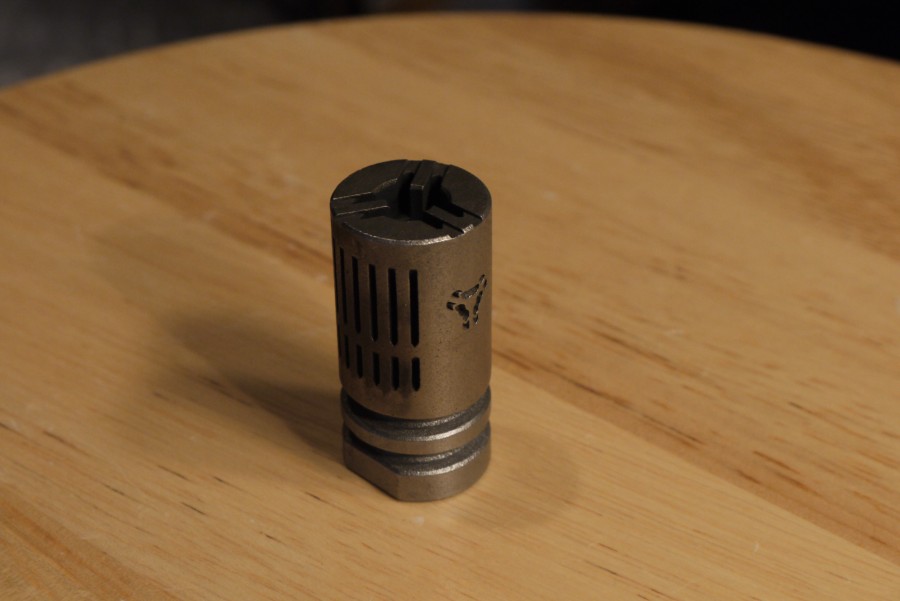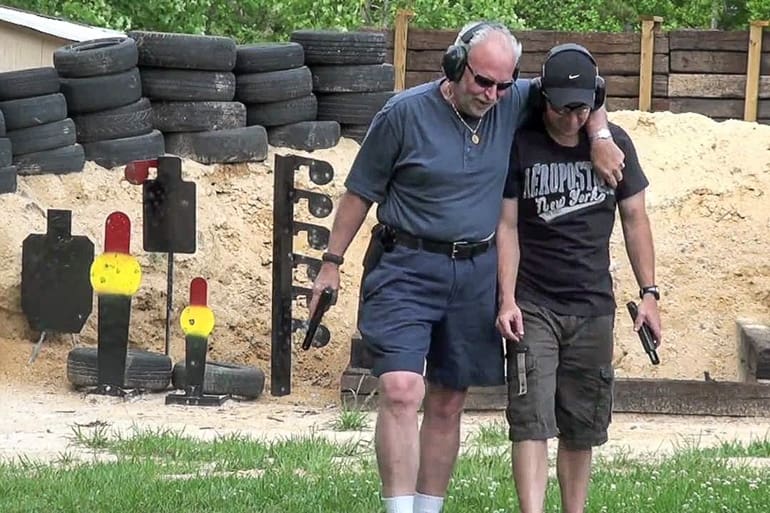We’ve been stuck in one hell of a rut for a very long time. Manufacturing processes haven’t really changed much in the last century, even including the advent of the CNC machine. Yeah it made things easier to make, but intricate internal designs have still eluded us. That is, until 3D printing started being possible with metals. And now, Neal Brace has come up with a 3D printed muzzle brake that is as compact as an A2 flash hider.
Some of you may remember Neal from his last invention, the No Stock Needed thinger. I had a chance to try it out before he decided to shelve the idea, and while it wasn’t particularly useful in and of itself, it definitely showed that Neal was thinking outside the box in terms of firearms related accessories. And this latest device is definitely new.
http://.com/watch?v=pZY90w0kHFA
I asked Neal what was the reason he wanted to design such a device, and apparently its all about taming the AR-15 pistol. “I was interested in making the AR pistol a worthwhile firearm by “taming” it,” he said, “since there’s no shoulder stock to steady the firearm under recoil. Most people see the AR pistol as a novelty. I see it, instead, as the future of firearms, because it is inherently lighter than a firearm with a shoulder stock, can accept any barrel length, and can be legally concealed or stored loaded in a vehicle. Basically, I said to myself that, if there was a way to mimic the benefits of the shoulder stock without the size, weight, and legal restrictions, I was going to find it.
“After testing the waters with the NSN (No Stock Needed) device last August and finding considerable resistance, I dropped those plans and went back to the drawing board. It took a few months to get to the heart of the problem and determine a solution that was palatable to the greatest number of shooting enthusiasts. I have to say that my buddies from my days in the Marines and my law enforcement friends were helpful in steering me in the right direction after my first foray into product development.
“The problem with normal AR pistols is recoil management, muzzle rise, and increased concussion with short barrels. Eliminate those variables and shot placement improves while shooting speed increases. The Auxetik brake is my solution to these problems.”
What has Neal excited the most about the new muzzle brake is that due to the nature of 3D printed parts, he can change the design drastically between production runs based on user feedback, and crank out an improved version without needing to change any tooling. All he needs to do is change the computer program to print a slightly different brake.
Asked why specifically 3D printing was necessary to make his dream muzzle brake a reality, Neal replied that ” since parts are built additively, layer by layer, instead of relying on casting or cutting tools, the inventor can design a part without worrying too much about internal or external geometry and completely forget about tooling. The reason why the Auxetik is so effective is because the internal passageways, which I’m calling 3D linear gas vents, are able to be built inside the device. They couldn’t be built any other way without significant headaches. With these 3D linear vents, the propellant gas is routed very similarly to a linear compensator before being expelled transversely. Most linear compensators offer little to no recoil and muzzle rise reduction, but by mating linear compensator technology into a transverse muzzle brake, the concussion experienced by the shooter is reduced and the overall recoil reduction is increased. It’s win-win-win.”
Neal sent me the prototype brake to try out, and I was very impressed. It worked as advertised, reducing felt recoil and muzzle climb more than the standard A2 flash hider. It’s not quite as good at recoil reduction as a traditional muzzle brake yet, but it’s still pretty good.
The real party trick of the brake, though, is the lack of a concussive blast coming from the ports. Traditional muzzle brakes produce a wave of exhaust gasses that annoy your neighbors at the shooting range, but Neal’s venting system redirects the gasses in such a way that there is no longer a concussion.
Neal is launching the thing officially on Monday, but since he cancelled my NDA a few hours ago I wanted to get this out to you guys ASAP. Pre-orders for the device start at $299, and the final list price is $399. It’s expensive, but as you can see from the videos, it works pretty well. Plus, 3D printing is just plain nifty.





You got to try one and let’s know the results, way cool , price is a little high , but that could come down !
Juggernaut Tactical: Call your office!
If you lived in a state that allows SBR’s you could convert your AR pistol to a SBR (tax included) for the price of that muzzle device.
Has he done stress testing and long term firing? One of the issues with printed parts would be how long they last, especially whe exposed to concussive forces over and over
This is made using a process called selective laser sintering. Basically a laser (or two) fuse the top surface of a vat of powder. The vat is lowered and more powder is smoothed over the top and the process is repeated. With metal you get about 85% of the strength of a machined or cast part. Since this is a relatively low stress part that should be more than enough, just don’t use it as a door knocker (breaching device). The problem, and part of the cost, is that the machines to do this start at around $750,000 in metal, about 1/3 of that if you just want to work in plastic.
You’ll notice this is printed in metal, not plastic, so longevity should be pretty good.
*yawn*
wake me up when I can print a shoulder thing that goes up.
I’m holding out for a 3D printed suppressor!
Worlds first?
Um…..no. Real gun companies do this stuff all the time for prototype work, and have for years. Then after the prototype is proven, first article samples are ordered and tested. Once those pass then production models are run and then we have $50-150 muzzle brakes.
I hope everyone enjoys their $400 prototypes.
My first AR ‘pistol’ only cost me twice the price of this device to build. The only device I can screw on the end of my barrel that I am willing to pay over $100 for also requires a $200 tax stamp 🙂
Hey, if you’ve got the disposable funds, go for it.
I sadly do not.
I’ll buy one and let you know what I think.
And I thought it was the weight and balance of AR-15 “pistols” (or stockless carbines) was the impediment to accuracy.
Comments are closed.